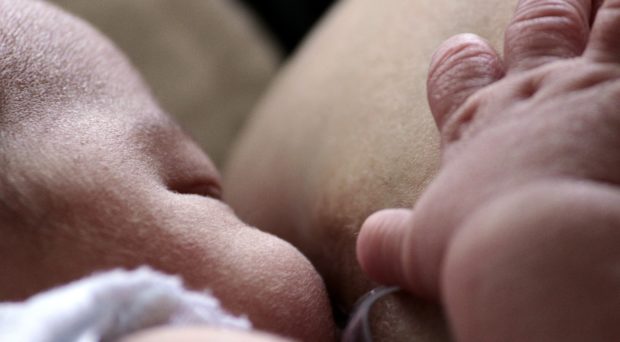
In this blog, Prof. Pietro Vajro (PV), Dr. Claudia Viggiano (CV) and Dr. Annachiara Occhinegro (AO) discuss their study published in Pediatric Research, where they compared the analgesic effect of sucking breast or formula milk while receiving routine childhood immunizations vs. holding only the child during the vaccines procedures of the first year of life.
What did the study find?
PV: We found that breastfed children showed the longest crying latency, i.e. the time in seconds elapsed between the introduction of the needle at the moment when the child starts to cry. Breast- and, surprisingly, also formula-fed children had the shortest crying duration, i.e. the time in seconds elapsed from the start of crying to the moment when the child stops crying for a period of silence of at least 5 seconds, and lowest age appropriate pain scores.
How can feeding exert its analgesic effect?
CV: For breastfeeding, the likely answer is that mechanisms involved are multifactorial and seem to include sucking, skin-to-skin contact, warmth, rocking, sound and smell of the mother, and probably endogenous opiates present in the breast milk as well. The analgesic effect of bottle feeding is more difficult to be explained, and probably may in part depend on a pacifier effect of the mere milk sucking itself.
Whether the intrinsic sweet-taste of milk itself is involved remains a possibility. In fact, the Canadian group of Taddio, by reviewing several studies conducted with sweet-tasting solutions, found that the administration of sucrose with or without non-nutritive sucking (i.e. use of a simple pacifier) was associated with less pain compared to no intervention or sterile water with or without non-nutritive sucking. Moreover, total cry duration was lower in infants who received sucrose than in those who received sterile water.
More recently Bos-Veneman et al showed that formula feeding is effective in mitigating pain due to vaccination shot among young 4-10 weeks infants in comparison with controls, but the two methods of feeding were not compared and data referred only to this very young age.
How did the mothers relate to this procedure?
AO: Interestingly, our research found that most mothers appreciated not only the respective feeding mediated pain mitigation method used but also the simply holding procedure. Embracing the child may help to reassure mothers: most mothers in the control group felt that holding their children was a reassuring measure per se.
This aspect warrants further evaluation in future studies as health care professionals may prefer to have the child on the exam table when administering vaccines. According to the Center for Disease Control, a parent’s embrace during vaccination offers several benefits. A comforting hold safely prevents children from moving their arms and legs during injections, and avoids frightening children by embracing them rather than overpowering them. This may encourage parents to nurture and comfort their child, and allows the health care professional steady control of the limb and the injection site. In all cases, in our study mothers felt reassured, with an unexpected frequent underestimation of their child pain during the shot.
PV: The study suggests that, as the promotion of this strategy is easily feasible and well accepted, it should be further encouraged within health professionals during vaccinations procedures. The new information is that both breastfed and formula-fed children may take advantage from our research results.
 Pietro Vajro is the Head of the Pediatrics Clinicl “San Giovanni di Dio e Ruggi d’Aragona” of the University Hospital of Salerno, Italy and Director of the Residency Program in Pediatrics at the Dept of Medicine, Surgery and Dentistry “Scuola Medica Salernitana” of the University of Salerno. Among his research areas in Pediatrics, he focuses on the humanization of medical care for in- and out-patients of pediatric age.
Pietro Vajro is the Head of the Pediatrics Clinicl “San Giovanni di Dio e Ruggi d’Aragona” of the University Hospital of Salerno, Italy and Director of the Residency Program in Pediatrics at the Dept of Medicine, Surgery and Dentistry “Scuola Medica Salernitana” of the University of Salerno. Among his research areas in Pediatrics, he focuses on the humanization of medical care for in- and out-patients of pediatric age.
 Claudia Viggiano is a medical doctor graduated at the Medical School of the University of Salerno, Italy. She is presently a 2nd year Resident in Pediatrics at the Medical School of the University of Milan. In this study, she has been involved with the research conduction since initial phases, with a leading role particularly in the interaction with the medical personnel of the Salerno Local Health Authority – Vaccination Clinics. The research was the subject of her MD Thesis.
Claudia Viggiano is a medical doctor graduated at the Medical School of the University of Salerno, Italy. She is presently a 2nd year Resident in Pediatrics at the Medical School of the University of Milan. In this study, she has been involved with the research conduction since initial phases, with a leading role particularly in the interaction with the medical personnel of the Salerno Local Health Authority – Vaccination Clinics. The research was the subject of her MD Thesis.
 Annachiara Occhinegro is a medical doctor graduated at the Medical School of the University of Salerno, Italy, and is planning to start pediatric studies. She had a leading role especially in the phases of the interviews of the vaccinated children’s families. This particular aspect of the research was the subject of her MD Thesis.
Annachiara Occhinegro is a medical doctor graduated at the Medical School of the University of Salerno, Italy, and is planning to start pediatric studies. She had a leading role especially in the phases of the interviews of the vaccinated children’s families. This particular aspect of the research was the subject of her MD Thesis.
Comments